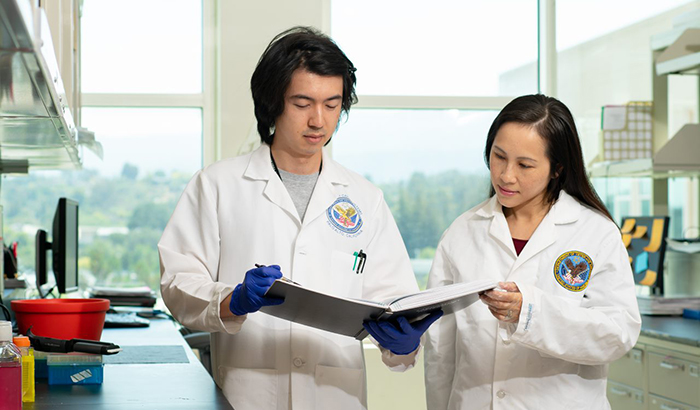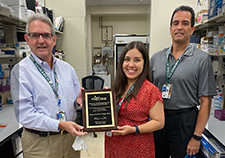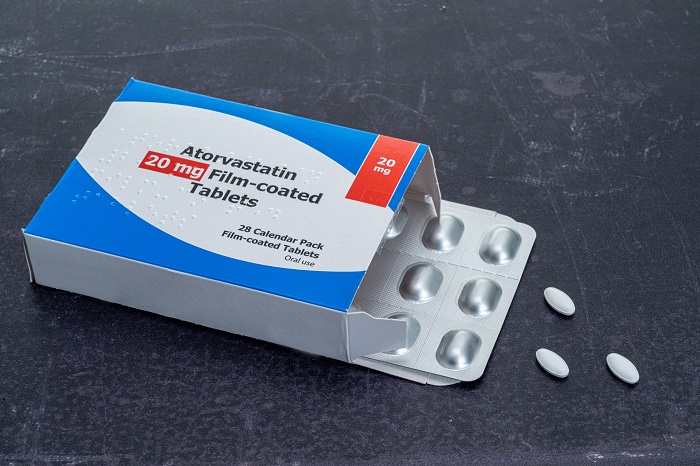Office of Research & Development |
 |


Dr. Alex Chan and Dr. Ngan Huang are studying a rodent model of peripheral artery disease to learn whether nicotine will block the creation of new blood vessels in response to therapeutic stem cells. (Photo by Adan Pulido)
September 1, 2020
By Mike Richman
VA Research Communications
"Not much is known about nicotine and its direct effect on therapeutic stem cells."
Many in the research community believe there is huge potential for stem cell therapy to treat a broad range of diseases. Stem cells, special human cells that can develop into many different cell types, essentially serve as a repair system for the body.
Currently, more than 5,000 clinical trials worldwide are based on therapeutic stem cells, including some at VA hospitals for illnesses ranging from cardiovascular disease to cancer.
But gaps remain in the transition of stem cell application from the research stage to patients.

VA Study Documents Health Risks for Burn Pit Exposures

VA center training the next generation of researchers in blood clots and inflammation

Could cholesterol medicine reduce dementia risk in seniors?

Under Secretary of Health, panel of experts discusses PACT Act impacts for Veterans
“One of these gaps is how a patient’s lifestyle choices and underlying health conditions may negatively affect stem cell therapy,” says Dr. Ngan Huang, a biomedical engineer at the VA Palo Alto Health Care System in California. “Given the prevalence of cigarette use and rise of electronic cigarettes, we believe this subject is an important aspect of stem cell application that remains unexplored. Not much is known about nicotine and its direct effect on therapeutic stem cells.”
Huang and Dr. Alex Chan, a postdoctoral research fellow at VA Palo Alto, are studying the effects of nicotine, a highly addictive tobacco stimulant normally inhaled with cigarettes, on therapeutic stem cells. The two co-authored a review article on the effects of nicotine on stem cell therapy that appeared online earlier this year in the journal Regenerative Medicine. Both scientists are also affiliated with Stanford University.
There are two arms to their study. In one, Huang and Chan are injecting cells into mice that have been exposed to nicotine, as well as those that haven’t, with the intention of treating peripheral artery disease, which obstructs blood vessels in the arms and legs. In the other arm, the researchers will compare stem cells in smokers and non-smokers. They will see if the groups differ at producing cells that are effective at making new blood vessels.
Veterans and service members are more likely to use tobacco products than civilians, according to the U.S. Centers for Disease Control and Prevention (CDC). CDC statistics show that about 30% of Veterans used some form of a tobacco from 2010 to 2015. Tobacco use was higher among Veterans than non-Veterans for males and females across all age groups, except men ages 50 and older.
Huang and Chan are hoping to bring more awareness about the effects of smoking on stem cells to the Veteran community, as well as other types of nicotine exposure that may impact the effectiveness of stem cell therapy, such as electronic cigarettes. E-cigarettes, also known as “vapes,” are battery-operated devices that people use to inhale an aerosol, which typically contains nicotine, flavorings, and other chemicals that are known to harm one’s respiratory system.
The effects of lifestyle and co-occurring health conditions on stem cells have been “largely neglected,” Chan explains. “Preclinical studies of stem cell therapies have mainly been conducted in healthy animal models. This does not reflect the settings in the clinics where patients requiring stem cell therapy may have underlying diseases, such as diabetes, high blood pressure, and lifestyle choices like smoking and diet.”
The lab study calls for exposing 10 mice to nicotine for a month, before they and another 10 mice that have not been exposed to nicotine are injected with stem cells. The researchers are then simulating a case of peripheral artery disease in each animal, before severing and removing one of the main arteries that supplies blood to the leg—the femoral artery. That will create a condition called critical limb ischemia, a blockage of the arteries that reduces blood flow to the hands, feet, and legs.
Huang and Chan believe the nicotine will prevent the ischemia leg from using the stem cells to create new blood vessels.
“We’re using this peripheral arterial disease model to mimic a real scenario where people who are prior or current smokers have peripheral artery disease,” Huang says. “We’re injecting stem cells into the ischemia leg to see if they are able to create new blood vessels. That’s something these therapeutic cells should normally be able to do.”
There are two main types of stem cells: pluripotent stem cells and adult stem cells. The research team is using endothelial cells that are generated from a form of pluripotent stem cells called induced pluripotent stem cells. Those cells are collected from a human donor and are altered to have elements like those of embryonic stem cells but do not trigger the same ethical concerns. They are often derived from skin cells or white blood cells but can also be generated from other kinds of cells. Once they are isolated from the donor, they go through genetic modification steps to turn them into induced pluripotent stem cells, which are being studied as a potential tool for drug development, disease modeling, and cell therapy.
Endothelial cells make up the inner layer of all blood vessels in the body.
“Those cells interact with blood all the time,” Huang says. “They are also the cells that are the first responders in terms of making new blood vessels. Whenever we have a disease or an injury where we need to create new blood vessels, the endothelial cells become activated and make the beginnings of new blood vessels.
“Capillaries, blood vessels that contain just the endothelial cells, are the most rudimentary blood vessels,” she adds. “That’s why endothelial cells are critical for making new blood vessels. In the case of peripheral artery disease and obstructed blood flow, the idea is to create new blood vessels that may be able to bypass the area of obstruction to allow the blood to flow through the leg. Think of peripheral artery disease as the main highway being clogged or obstructed. The endothelial cells are trying to create side streets and other kinds of detours to allow blood to flow through the leg.”
Huang’s lab also works with adult stem cells called mesenchymal stem cells, which live in bone marrow and fat tissue.
Generally, Chan says, nicotine reacts similarly in different types of stem cells because it’s known to interact through one type of receptor on the cells. “There are some studies suggesting that induced pluripotent stem cells are more resistant to cigarette smoke exposure compared to mesenchymal stem cells,” he notes. “However, these studies are quite narrow in their scope and more research is needed to validate such findings.”
In the other arm of the study, the researchers will compare endothelial cells that are produced from induced pluripotent stem cells in three smokers and three non-smokers. They will see if the groups are different at producing cells that are effective at making new blood vessels. The smokers will have no major co-occurring health conditions. “Our belief is that chronic nicotine exposure, such as long-term smokers, will make cells isolated from the patients less likely to be functional,” Huang says. “At the same time, inflammatory bodily effects on long-term smokers may also hinder the actions of stem cell therapy.”
The overall results from the study, Huang notes, may prompt researchers to take nicotine or tobacco exposure into consideration in clinical trials. As more trials take place for stem cell therapies in many applications, she says, the field will trend toward more effective therapies.
“But with many unknowns, it will be years before stem cells therapies become the gold standard treatment for certain diseases,” she says.
VA Research Currents archives || Sign up for VA Research updates